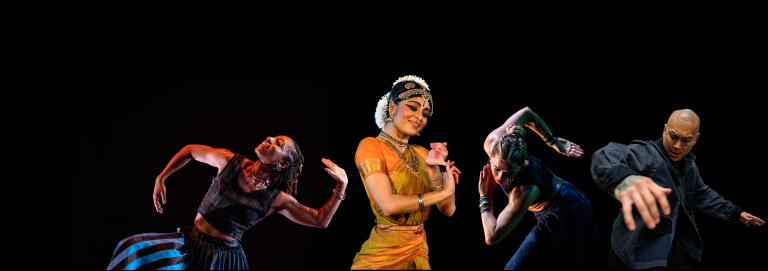
The Great Northern, The Cowles Center, and Northrop Present
Ashwini Ramaswamy and Kevork Mourad: Invisible Cities
Past event
Jan 27, 2023
Jan 28, 2023
Captioning
Bharatanatyam choreographer and dancer Ashwini Ramaswamy (Ragamala Dance Company) deepens a choreographic methodology she began in 2019 with Let the Crows Come—named a “Best of the Year'' in The Washington Post and a critic’s pick in The New York Times. This collaborative reimagining of Italo Calvino’s metaphysical novel interweaves cultural perspectives with a dynamic group of dance artists—Ranee and Aparna Ramaswamy (Bharatanatyam), Berit Ahlgren (Gaga), Alanna Morris (Modern), Joseph Tran (Breaking)—and visual artist, Kevork Mourad, who creates Invisible Cities’ interactive, immersive projections in real time.
Ashwini Ramaswamy and Kevork Mourad: Invisible Cities is a Northrop Centennial Commission.
“Ramaswamy’s imagination had united and flourished, making space, not just for more generations but for more ways of thinking.” —The New York Times
Build your flexible, Create Your Own Package with any 3 or more in-person events from the 2022-23 Dance Series or Music Series and save 15%!
The content below derives from the Northrop Across Campus Program that supports Northrop's mission towards intersections between performing arts and education for the benefit of all participants now and for generations to come.
Find ways to make thematic connections to these suggested topics:
Take a deeper dive with these resources that provide additional information about the performers, the history of the artform, and the artistic process.
Ashwini Ramaswamy – Artist website
Lit Hub – Why Is Calvino Italo So Beloved Outside Italy?
Berit Ahlgren’s – Artist website
Alanna Morris – Artist website
Start a conversation about the performance, or encourage reflection, using these questions as inspiration.
Ashwini Ramaswamy’s Invisible Cities is a reimagination of Italo Calvino’s metaphysical/philosophical novel Invisible Cities for the stage. Ramaswamy draws from the myths and culture of her homeland to resurrect her relationship with the past and reprocess that past into the present. Her work is aimed at second and third generation immigrants longing to make connections between the ancestral and the current.
Working with groups of dancers of four diverse cultural backgrounds and dance lineages (Bharatanatyam led by Ramaswamy, Gaga technique led by Berit Ahlgren, Contemporary/African Diasporic led by Alanna Morris-Van Tassel, and Breaking led by Joseph Tran), Ramaswamy deepens a unique choreographic methodology of reinterpretation, anchored in the South Indian classical dance form.
Ramaswamy will also be collaborating with internationally renowned artist Kevork Mourad to create an interactive experience using animation. According to The Great Northern's website, Mourad’s “visual architectures provide a dynamic and unpredictable dimension to the artists’ examination of the way the built environment and human life interact.”
Ramaswamy’s work, according to the The New York Times, has been described as a “weaving together, both fearfully and joyfully of the human and the divine.” As an artist of the diaspora, she refers to herself as a “cultural carrier with an instinct to move within ancestral patterns.”
This activity is made possible by the voters of Minnesota through a Minnesota State Arts Board Operating Support grant, thanks to a legislative appropriation from the Arts and Cultural Heritage Fund.
This project is supported in part by the National Endowment for the Arts. To find out more about how National Endowment for the Arts grants impact individuals and communities, visit www.arts.gov.